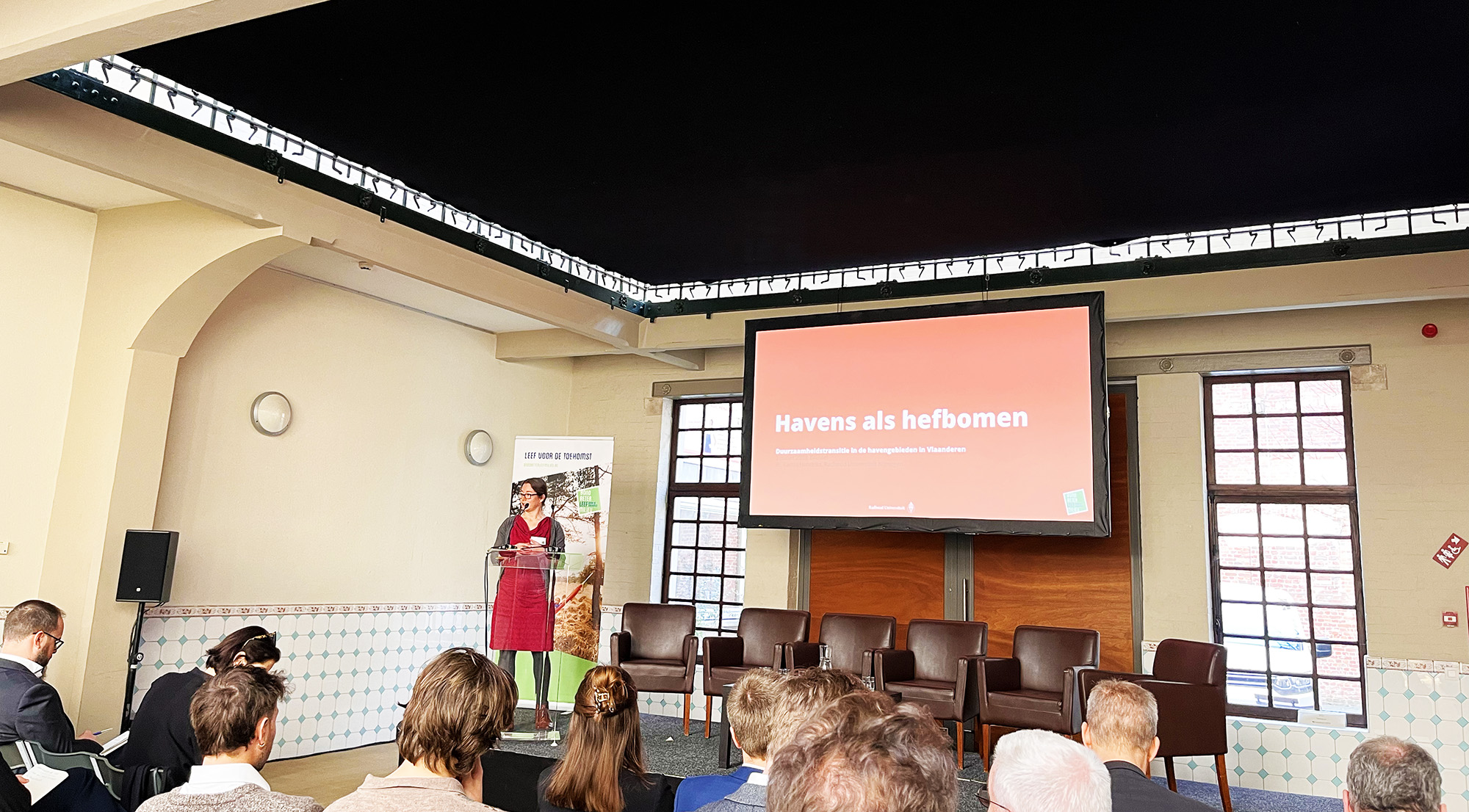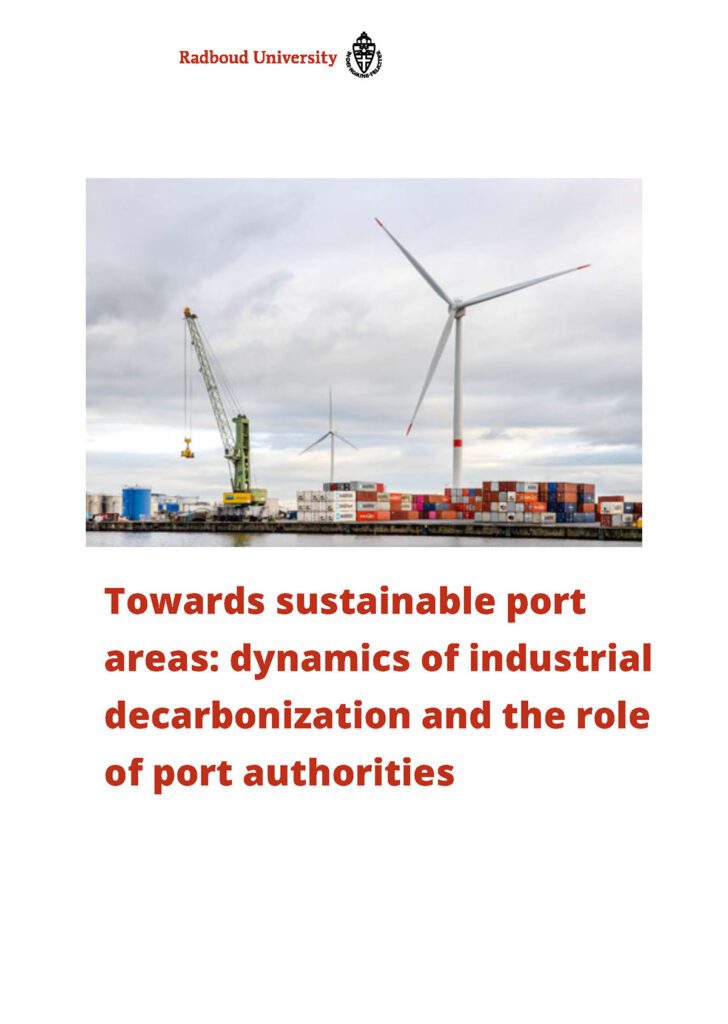The new report “Towards sustainable port areas: dynamics of industrial decarbonization and the role of port authorities” was presented in Brussels by Dr. Carlijn Hendriks of the Radboud University of Nijmegen.
This independent study (further referred to as the Radboud report) was commissioned by the Belgian NGO Bond Beter Leefmilieu. The research is based on a literature review, the documents from all the stakeholders involved and interviews with 25 stakeholders in 5 European ports: North Sea Port, Antwerp-Bruges, Rotterdam, Hamburg, Barcelona. The central question guiding the study was ‘how can port authorities contribute to accelerate the climate and circularity transition?’
The challenges set by the Paris Climate Agreement and the European Green Deal, to reduce CO2 emissions by 55% by 2030 and achieve net zero emissions by 2050, require huge transformations in the ports of the Delta region. “These transformations are not only a vital contribution to limiting climate change and resource scarcity but are also important for ports and industrial clusters to remain competitive and relevant, and maintain a social licence to operate”, the new report states in its introduction.
It appears ports in general are finding it difficult to formulate the long-term strategies. The report states: “While ports are clearly developing several projects that contribute to decarbonization of port operations and logistics, a roadmap towards fully climate neutral operations and logistics that extends beyond the current strategies (running to 2025 for both North Sea Port and the Port of Antwerp-Bruges) was not found.”
Carbon lock-in and deep decarbonization
Dr. Carlijn Hendriks clearly highlighted the risk of overlooking the long-term perspective. “(There is) A general risk of emphasizing the short-to-medium term over the long term is that of carbon lock-in (…) In general, prioritizing short-term over long-term decarbonization targets can result in too much emphasis on incremental emission reduction technologies rather than deep emission reduction technologies and the development of new climate-neutral and circular value chains.”
In other words, if ports focus only on the targets set for 2030, they may face insurmountable problems with the remaining decarbonization required to achieve the net-zero emissions target by 2050.
This is the reason for the report to stress the development of roadmaps for the whole transformation. Interestingly, therefore, discussions cannot ignore the most difficult parts of the transformation today, in the hope of overcoming them later. It’s better to face the difficulties as soon as possible, the authors seem to want to emphasise when they distinguish between ‘decarbonising’ and ‘deep decarbonising’.
In this light, the Radboud report suggests that Carbon Capture and Storage (CCS) and Carbon Capture and Utilisation (CCU) should be evaluated. If CCS and CCU only serve to delay the release of carbon into the atmosphere, it will not solve the problems we face. CCS can lead to carbon lock-ins. Whereas, plans for the decarbonization of industrial feedstocks are much less concrete and rely heavily on hopes for CCU applications, many of which are not compatible with the Paris Agreement targets.
We need circularity at the heart of the transition
Another interesting aspect is what are known as ‘scope 3 emissions’. Scope 3 emissions are indirect greenhouse gas (GHG) emissions that occur in a company’s value chain, including its suppliers, customers, and end-users. Dr. Carlijn Hendriks: “Achieving climate neutrality from a ‘scope 3 perspective’ requires circularity in materials (Agora Industry, 2022). This further underlines the need to enhance the focus on the development of circular value chains and develop a long-term perspective that views the decarbonization and circularity transitions as one undivided development.” In other words, there will be no ‘scope 3 achievements’ without a circular transition. The report notes that ambitions for circularity are formulated, but concrete plans and projects are limited so far.
The Radboud report recommends three actions (out of a total of 18) in relation to circularity:
- Develop a vision of what a circular society looks like and how to get there. Include circularity in decarbonization roadmaps since Scope 3 decarbonization requires circular material flows. Both port authorities and governments could take the initiative, and both should be actively involved in the process.
- Work with the port industry to broaden the scope of circularity activities beyond recycling and focus more on the higher-order forms of circularity (refuse, reduce, resell/reuse, repair, refurbish, remanufacture, and repurpose).
- Apply rigorous circularity and decarbonization criteria when reviewing potential tenant applications, adopt circularity indicators (see Verbeke et al. (2022) for suggested indicators) in performance metrics and reporting, and include these metrics in decision-making.
Community trust as a prerequisite
The Radboud report also identifies three overarching levers that port authorities and regional and national governments can use to accelerate the transformation of port industrial complexes towards sustainability:
- Facilitate the introduction and implementation of new technologies for the short to medium term, but also strengthen the introduction of other technologies for the medium to long term.
- Focus not only on creating/facilitating of new, carbon-free sustainable value chains, but also on phasing out of fossil-based value chains.
- Strengthen the societal dialogue on decarbonization and circularity of heavy industry and involve stakeholders and the general public from the start. A relationship of mutual trust between industry, governments and the public are a prerequisite for a successful transition to climate neutrality and circularity.
Different roles for ports were identified. Port authorities are operators, landlords, regulators (including enforcement and land-use planning) and community managers. In each of these roles they can promote the greening of all port operations. The last role, as community manager, is the one often mentioned in the third lever identified above.
The Radbound report notes that “stakeholders in and beyond the port area are generally very appreciative when the port authority takes the initiative to strengthen or start multi-stakeholder collaborations.” This was the case with the development of Antwerp@C, a collaboration between the Port of Antwerp-Bruges, Fluxys and six industrial partners. The project focuses on CCS, and later, the reuse of CO2 as raw material for different CCU applications.
Port authorities are more reluctant to engage with the public. Dialogue with the public is seen as complex and ineffective. However, the Radboud report clearly states that societal engagement on future strategies for ports and the future of the industry in a climate-neutral and circular world, is important to build trust. A public mandate will be a prerequisite for adapting port operations and infrastructure to the sustainable transition. The report quotes one interviewee with a reaction that is particularly relevant in this regard: “People want to move towards sustainable industry, but they also don’t like change. So there is a paradox there. [… Local residents] are focused on the quality of their environment, they don’t want noise or odour pollution, and that is fair. People are under the impression that a decarbonized industry will be clean, quiet, and odourless, but that is not the case; you are reducing oil use but that needs to be replaced by other feedstocks.” If public trust turns into public resistance, the results can be much worse. The report cites the example of Rotterdam where public opposition to windmills was much higher than against the industrial expansion.
Roadmap development by port authorities
The Radboud report places great emphasis on the development of roadmaps by port authorities, in collaboration with port communities, governments and the general public. The roadmaps should be compatible with the Paris Climate Agreement and the Green Deal. “This would give greater clarity for companies who will be able to align their strategies to the backbone that a roadmap for the entire port area would provide. Additionally, an ambitious decarbonization and circularity roadmap could increase a region’s attractiveness for new and innovative business that have sustainable practices ingrained in their business models, further enhancing deep decarbonization and the circularity transition.” Roadmaps can thus serve to give each of the above levers its place in the port transformation.
Let the debate continue!
The Radboud report has its merits in bringing together many of the common debates around the transformation of ports (and port areas) and in identifying the challenges and pitfalls associated with some of the most frequently mentioned solutions, such as the new hydrogen economy and carbon capture and storage. In this context, port authorities should fundamentally rethink their role to embrace the transition to a circular, low-carbon economy.
The report also reiterates that port authorities should work on roadmaps without losing sight of the integration of deep decarbonisation, circularity and the long term. The researchers provide general but clear recommendations, with 3 key levers and 18 concrete actions providing practical guidance. ‘Doing the right things’ means creating the vision and the roadmap, but it goes hand in hand with ‘doing the things right’. Increased transparency will lead to better decision making and thus a way forward to seize opportunities.
A good starting point is the impetus for a Circular Port Monitor. The current momentum around circular economy monitoring and the evolving role of port managers in sustainability reporting is an excellent opportunity to clarify the direction in which this should be integrated into port performance systems. This is the time to establish the right framework and context to take incremental steps towards a mature circular economy monitoring system in port areas.




